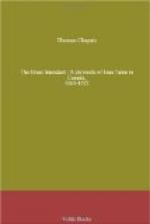Another enterprise of the intendant was numbering the people. Under his personal supervision, during the winter of 1666-67, a general census of the colony was taken—the first Canadian census of which we have any record. The count showed, as we have already said, a total population of 3215 in Canada at that time—2034 males and 1181 females. The married people numbered 1109, and there were 528 families. Elderly people were but few in number, 95 only being from fifty-one to sixty years old, 43 from sixty-one to seventy, 10 from seventy-one to eighty, and 4 from eighty-one to ninety. In regard to professions and occupations, there were then in New France 3 notaries, 5 surgeons, 18 merchants, 4 bailiffs, 3 schoolmasters, 36 carpenters, 27 joiners, 30 tailors, 8 coopers, 5 bakers, 9 millers, 3 locksmiths. The census did not include the king’s troops, which formed a body of 1200 men. The clergy consisted of the bishop, 18 Priests and aspirants to the priesthood, and 35 Jesuit fathers. There were also 19 Ursulines, 23 Hospitalieres, and 4 Sisters of the Congregation. The original record of this, the first Canadian census, has been preserved and is without question a most important historical document. It is likewise full of living interest, for in it are recorded the names of many families whose descendants are now to be found all over Canada.
CHAPTER III
THE IROQUOIS SUBDUED
It was the special task of Tracy and Courcelle to rid the colony of the Iroquois scourge. The Five Nations [Footnote: The Iroquois league consisted of five tribes or nations—the Mohawks, the Cayugas, the Senecas, the Onondagas, and the Oneidas.] had heard with some disquietude of the body of trained soldiers sent by the French king to check their incursions and crush their confederacy. At the beginning of December 1665, the Marquis de Tracy received an embassy from the Onondagas. They desired to enter into a peace negotiation, and one of the most noted chiefs, Garakonthie, delivered on that occasion a long and eloquent address to the viceroy. A treaty was signed by them on behalf of their own and two of the other tribes, the Senecas and the Oneidas. But meanwhile the Oneidas did not cease from hostilities, and the Mohawks also continued their bloody raids against the French settlements. Courcelle therefore decided to march at once against their villages beyond Lake Champlain, in what is now New York state and to teach them a lesson. But he did not know the nature of a winter expedition in this northern climate. Leaving Quebec on January 9, he reached Three Rivers on the 16th, and proceeded to Fort Saint-Louis on the Richelieu, where he had fixed the rendezvous of the troops. The cold was very severe, and many soldiers were frozen at the outset. On January 29 the little band, five or six hundred French and Canadians, left Fort Saint-Louis, unfortunately without waiting for a party of Algonquins who should have




